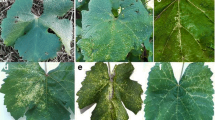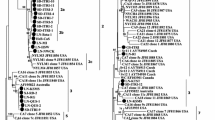Summary.
The naturally occurring Grapevine fanleaf virus (GFLV) recombinant isolate A17b was recovered from its grapevine host by sap inoculation and serial passages onto Gomphrena globosa, a pseudo local lesion herbaceous host, and Chenopodium quinoa, a systemic herbaceous host, to characterize some of its biological properties. Sequence analysis of the CP gene, in which a recombinational event was previously detected, demonstrated the genetic stability of recombinant isolate A17b over a 5-year period in its natural host as well as in C. quinoa. Also, recombinant isolate A17b was graft transmissible, as shown by an in vitro heterologous approach, and transmitted by the nematode Xiphinema index as readily as nonrecombinant GFLV isolates. Furthermore, despite a lower pathogenicity on Chenopodium amaranticolor, recombinant isolate A17b had a similar host range and induced similar symptoms in type and severity to nonrecombinant GFLV isolates. Interestingly, the use of infectious chimeric RNA2 transcripts in combination to RNA1 transcripts of GFLV strain F13 suggested no implication of the recombination event in the CP gene of isolate A17b in the reduced pathogenicity on C. amaranticolor. Altogether, recombinant isolate A17b had similar biological properties to GFLV nonrecombinant isolates.
Similar content being viewed by others
References
R Aaziz M Tepfer (1999) ArticleTitleRecombination in RNA viruses and in virus-resistant transgenic plants. J Gen Virol 80 1339–1346
RF Allison WL Schneider AE Greene (1996) ArticleTitleRecombination in plants expressing viral transgenes. Sem Virol 7 417–422
P Andret-Link C Laporte L Valat C Ritzenthaler G Demangeat E Vigne V Laval P Pfeiffer C Stussi-Garaud M Fuchs (2004) ArticleTitleGrapevine fanleaf virus: still a major threat to the grapevine industry. J Plant Pathol 86 183–195
P Andret-Link C Schmitt-Keichinger G Demangeat V Komar M Fuchs (2004) ArticleTitleThe specific transmission of Grapevine fanleaf virus by its nematode vector Xiphinema index is solely determined by the viral coat protein. Virology 320 12–22
C Belin C Schmitt F Gaire B Walter G Demangeat L Pinck (1999) ArticleTitleThe nine C-terminal residues of grapevine fanleaf nepovirus movement protein are critical for systemic virus spread. J Gen Virol 80 1347–1356
C Belin C Schmitt G Demangeat V Komar L Pinck M Fuchs (2001) ArticleTitleInvolvement of RNA 2-encoded proteins in the specific transmission of Grapevine fanleaf virus by its nematode vector Xiphinema index. Virology 291 161–171
SW Ding BJ Shi WX Li RH Symons (1996) ArticleTitleAn interspecies hybrid RNA virus is significantly more virulent than either parental virus. Proc Natl Acad Sci USA 93 7470–7474
I Fernandez T Candresse O Le Gall J Dunez (1999) ArticleTitleThe 5′ noncoding region of Grapevine chrome mosaic nepovirus RNA-2 triggers a necrotic response on three Nicotiana spp. Mol Plant Microbe Interact 12 337–344
MJ Gibbs JS Armstrong AJ Gibbs (2000) ArticleTitleSister-scanning: a Monte Carlo procedure for assessing signals in recombinant sequences. Bioinformatics 16 573–582
BD Harrison AF Murant MA Mayo IM Roberts (1974) ArticleTitleDistribution of determinants for symptom production, host range and nematode transmissibility between the two RNA components of raspberry ringspot virus. J Gen Virol 22 233–247
R Legin P Bass L Etienne M Fuchs (1993) ArticleTitleSelection of mild virus strains of fanleaf degeneration by comparative field performance of infected grapevines. Vitis 32 103–110
Mayo MA, Robinson DJ (1996) Nepoviruses: Molecular Biology and Replication, BD Harrison and AF Murant (eds), The plant viruses, vol 5: Polyhedral virions and bipartite RNA genomes. Plenum Press, New York, pp 139–185
F Monci S Sanchez-Campos J Navas-Castillo E Moriones (2002) ArticleTitleA natural recombinant between the geminiviruses Tomato yellow leaf curl Sardinia virus and Tomato yellow leaf curl virus exhibits a novel pathogenic phenotype and is becoming prevalent in Spanish populations. Virology 303 317–326
P Naraghi-Arani S Daubert A Rowhani (2001) ArticleTitleQuasispecies nature of the genome of Grapevine fanleaf virus. J Gen Virol 82 1791–1795
T Rubio M Borja HB Scholthof AO Jackson (1999) ArticleTitleRecombination with host transgenes and effects on virus evolution: An overview and opinion. Mol Plant Microbe Interact 12 87–92
MA Serghini M Fuchs M Pinck J Reinbolt B Walter L Pinck (1990) ArticleTitleRNA2 of grapevine fanleaf virus: sequence analysis and coat protein cistron location. J Gen Virol 78 3171–3176
JE Schoelz WM Wintermantel (1993) ArticleTitleExpansion of viral host range through complementation and recombination in transgenic plants. The Plant Cell 5 1669–1679
JD Thompson DG Higgins TJ Gibson (1994) ArticleTitleCLUSTAL W. Improving the sensitivity of progressive multiple sequence alignment through sequence weighting, positions-specific gap penalties and weight matrix choice. Nucleic Acids Res 22 4673–4680
M Varrelmann L Palkovics E Maiss (2000) ArticleTitleTransgenic or plant expression vector-mediated recombination of Plum pox virus. J Virol 74 7462–7469
E Vigne M Bergdoll S Guyader M Fuchs (2004) ArticleTitlePopulation structure and genetic diversity within Grapevine fanleaf virus isolates from a naturally infected vineyard: evidence for mixed infection and recombination. J Gen Virol 85 2435–2445
E Vigne V Komar M Fuchs (2004) ArticleTitleField safety assessment of recombination in transgenic grapevines expressing the coat protein gene of Grapevine fanleaf virus. Transgenic Res 13 165–179
M Viry MA Serghini F Hans C Ritzenthaler M Pinck L Pinck (1993) ArticleTitleBiologically active transcripts from cloned cDNA of genomic grapevine fanleaf nepovirus RNAs. J Gen Virol 74 169–174
A Vuittenez MC Munck J Kuszala (1964) ArticleTitleSouches de virus à hautes aggressivité isolées de vignes atteintes de dégénérescence infectieuse. Etudes Virol Appl 5 69–78
B Walter L Etienne (1987) ArticleTitleDetection of the grapevine fanleaf viruses away from the period of vegetation. J Phytopathol 120 355–364
T Wetzel L Meunier U Jaeger GM Reustle G Krczal (2001) ArticleTitleComplete nucleotide sequences of the RNAs 2 of German isolates of Grapevine fanleaf and Arabis mosaic nepoviruses. Virus Res 75 139–145
T Wetzel M Fuchs M Bobko G Krczal (2002) ArticleTitleSize and sequence variability of the Arabis mosaic virus protein 2A. Arch Virol 147 1643–1653
Author information
Authors and Affiliations
Rights and permissions
About this article
Cite this article
Vigne, E., Demangeat, G., Komar, V. et al. Characterization of a naturally occurring recombinant isolate of Grapevine fanleaf virus. Arch Virol 150, 2241–2255 (2005). https://doi.org/10.1007/s00705-005-0572-3
Received:
Accepted:
Published:
Issue Date:
DOI: https://doi.org/10.1007/s00705-005-0572-3




